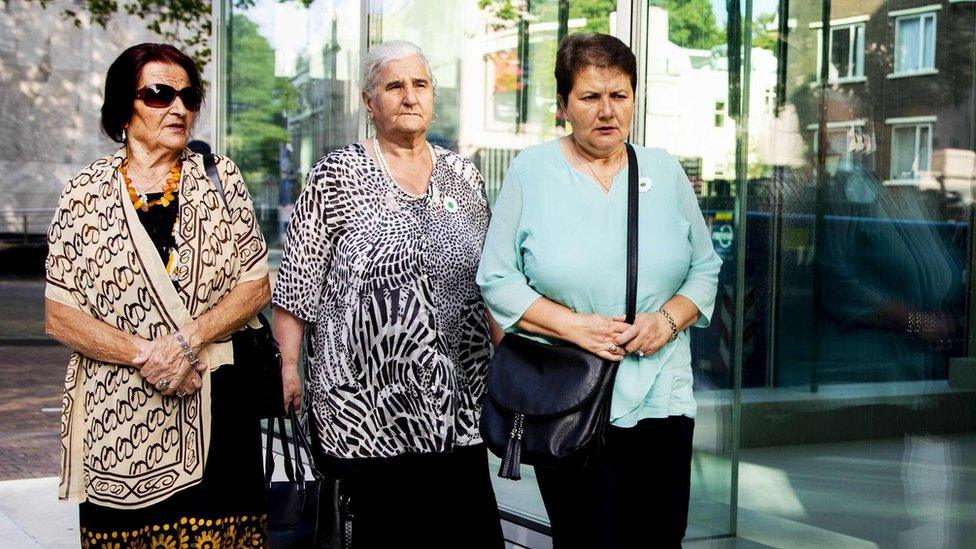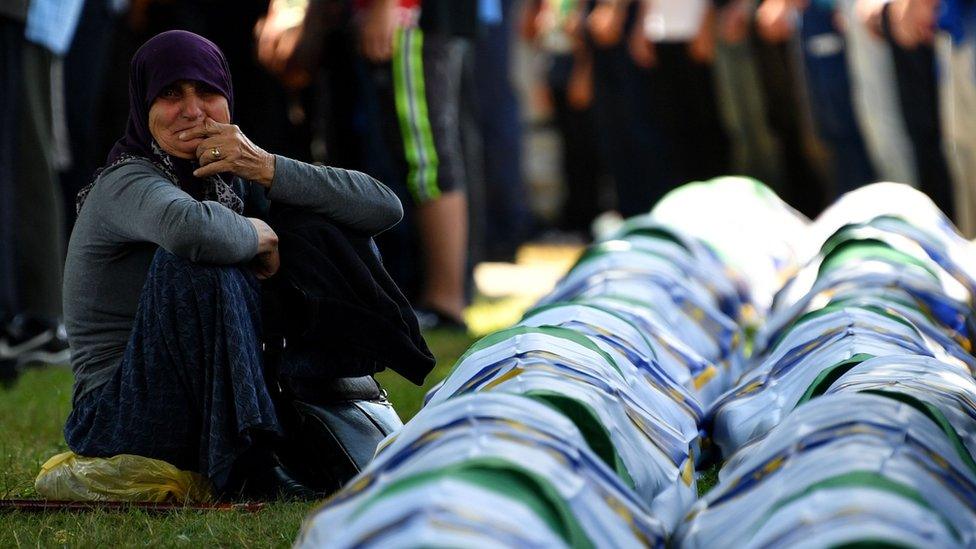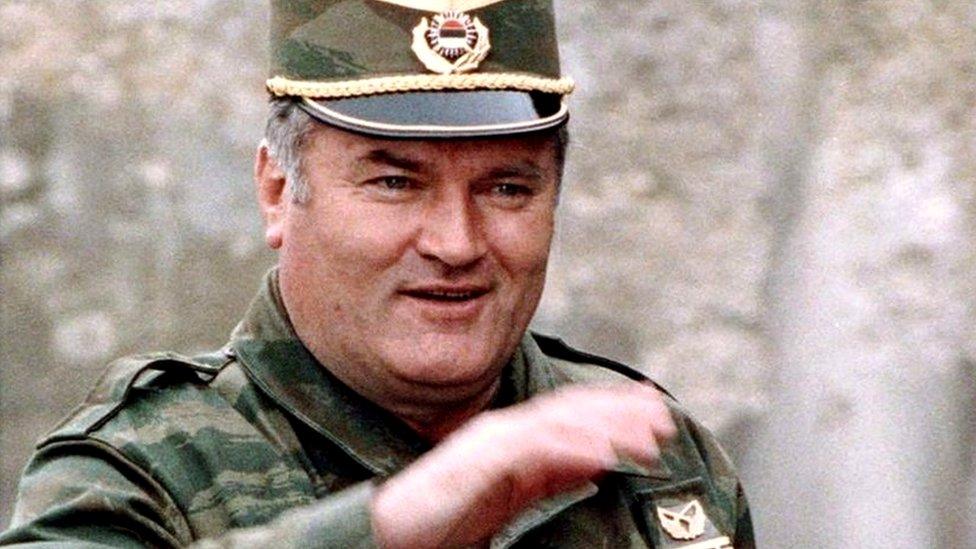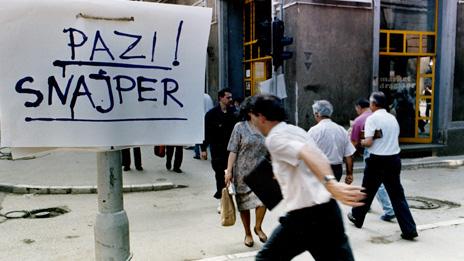Srebrenica massacre: Dutch state '10% liable' for 350 deaths
- Published
What happened at Srebrenica? Explained in under two minutes
The Dutch supreme court has upheld a ruling that the state was partially responsible for 350 deaths in Bosnia's Srebrenica massacre.
The court said the state had 10% liability, as this was the probability that its soldiers could have prevented the killings.
Bosnian Serb forces killed a total of 8,000 Muslim men in the town of Srebrenica in 1995.
The Dutch had been guarding a UN safe zone when it was overrun.
It is rare for a state to be held responsible for failures in UN peacekeeping work, but the court emphasised that the Netherlands bore "very limited liability".

Women from the Mothers of Srebrenica campaigning group said they were disappointed by the ruling
In 2002, a report into the Netherland's role, external in Srebrenica caused the entire Dutch government to resign.
The Dutch defence ministry said the government had accepted the Supreme Court's verdict on Friday, including liability for any damages.
What did the court say?
The court ruled that if Dutch forces had given 350 men hiding in the UN compound the chance to stay, there was just a 10% chance they would not have fallen into the hands of the Serbs, and so the Dutch state should be liable for only that proportion of the damages suffered by the bereaved.
The ruling did not give details on how it calculated the 10% chance of survival.
The final verdict draws a line under years of legal battles between the Dutch state and the plaintiffs - a group of victims' relatives known as the Mothers of Srebrenica.
The case was escalated to the highest court because the state wanted to be cleared of responsibility, while the Mothers of Srebrenica wanted it to be held accountable for all 8,000 deaths in the genocide.
An appeals court had previously set the liability at 30%, but the supreme court's ruling has drastically reduced that figure, external.


In the front row of court sat the women who call themselves the Mothers of Srebrenica.
A formidable trio who lost husbands, sons and fathers in the Srebrenica massacre and have made this pursuit of justice their mission in life.
Sitting a few seats away from them, I was surprised these normally vocal women remained silent as the judgment was read out. When we got outside, one of them, Munira Subasic, explained why.
"It was a humiliation again. Just like in 1995 the Dutch were in charge, and we didn't know what was going on."
The Netherlands' highest court had failed to provide them with a live translation.
Bringing back those memories of the moments before the massacre when they were herded into groups by the Dutch peacekeepers and evacuated through tunnels, with deportation buses on one side with Bosnian Serb forces. It was at this point the men were plucked from the crowds and taken away to be executed.
Asked if Munira felt the acknowledgment of 10% Dutch culpability for the deaths of the 350 Muslim men who'd been secretly hiding in the compound was a vindication she shook her head.
"I only got a few bones from my son back, about 3%, the rest is still missing."

Former members of the Dutch forces (known as Dutchbat) attending the hearing expressed their disappointment over the ruling. Veteran Remko de Bruijne told the BBC it would bring little comfort to relatives of those who died, and called it "a disgrace".
What happened at Srebrenica?
During the Bosnian War (1992-1995), the Serb army was engaged in an ethnic-cleansing operation.
Thousands of Muslims sought safety in Srebrenica, which the UN was protecting with Dutch forces, but the area fell in July 1995 during a Serb offensive led by General Ratko Mladic.
When the Serb army moved in to Srebrenica, approximately 20,000 Muslims - mostly women, children and the infirm - sought refuge in the Dutch compound in nearby Potocari.

A woman with newly identified victims' bodies in 2019
As the violence escalated, the Dutch surrendered and later agreed to help the Serbs load Muslim refugees on to buses.
What about the 350 men?
They were inside the compound, but according to the ruling, the Serbs were not aware of them at the time.
The court said the Dutch force had "failed to offer these 350 male refugees the choice to stay where they were, even though that would have been possible".
They were eventually among those made to leave the base. The court said "this failure on Dutchbat's part denied these male refugees the chance to stay out of the hands of the Bosnian Serbs".
It said the chance that they would have survived if they had stayed "was small but not negligible".
The ruling confirms that surviving relatives of the 350 men may claim compensation from the Dutch state.
The Mothers of Srebrenica had originally sought acknowledgement and compensation from the UN as well, but the organisation was ruled to be immune from prosecution.

Timeline of Srebrenica siege
6-8 July 1995: Bosnian Serb forces start shelling Srebrenica enclave
9 July: Bosnian Serbs step up shelling; thousands of Bosnian Muslim refugees flee to Srebrenica
10 July: Dutch peacekeepers request UN air support after Bosnian Serbs shell Dutch positions. Large crowds of refugees gather around Dutch positions
11 July: More than 20,000 refugees flee to main Dutch base at Potocari. Serbs threaten to kill Dutch hostages and shell refugees after Dutch F-16 fighters bomb Serb positions. Bosnian Serb commander Ratko Mladic enters Srebrenica and delivers ultimatum that Muslims must hand over weapons
12 July: An estimated 23,000 women and children are deported to Muslim territory; men aged 12-77 taken "for interrogation" and held in trucks and warehouses
13 July: First killings of unarmed Muslims take place near village of Kravica. Peacekeepers hand over some 5,000 Muslims sheltering at Dutch base in exchange for the release of 14 Dutch peacekeepers held by Bosnian Serbs
14 July: Reports of massacres start to emerge
- Published22 November 2017

- Published18 March 2016
